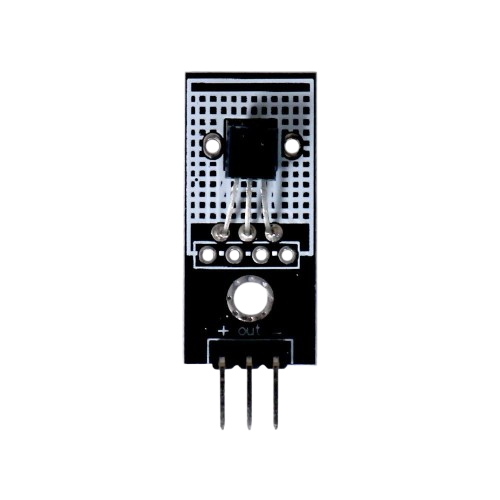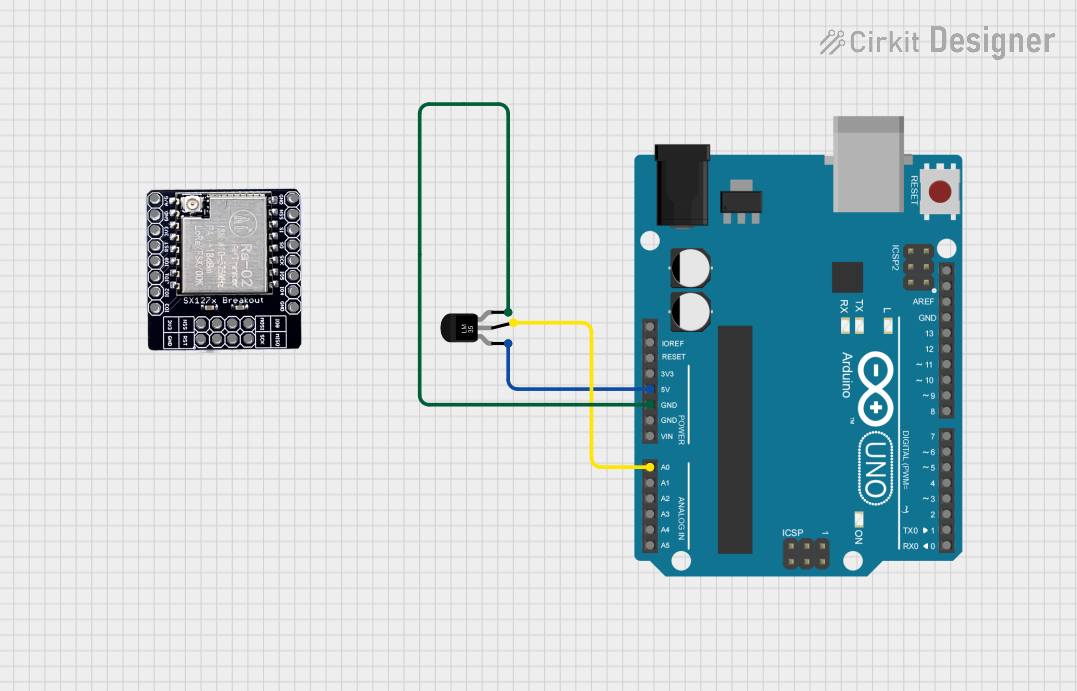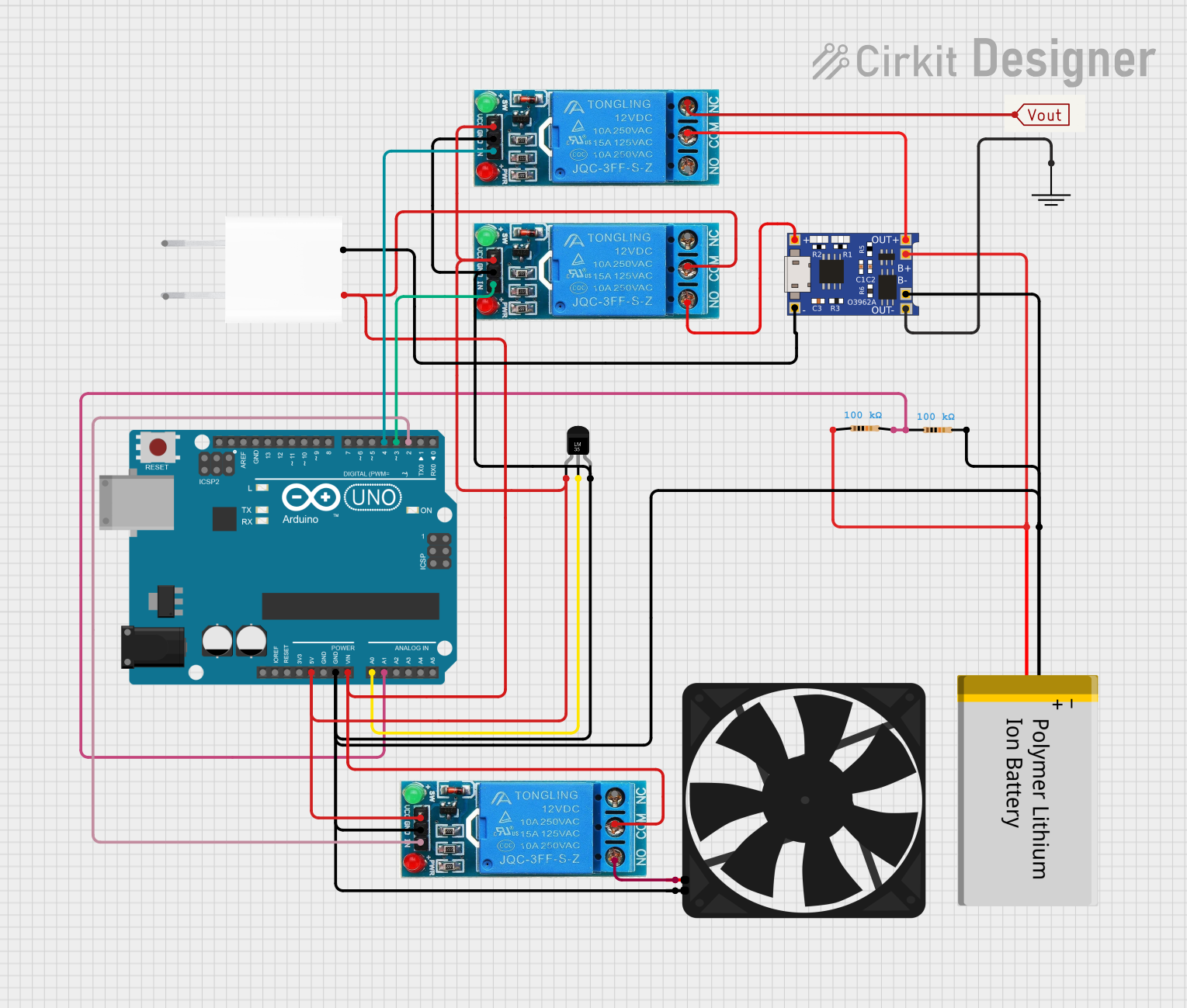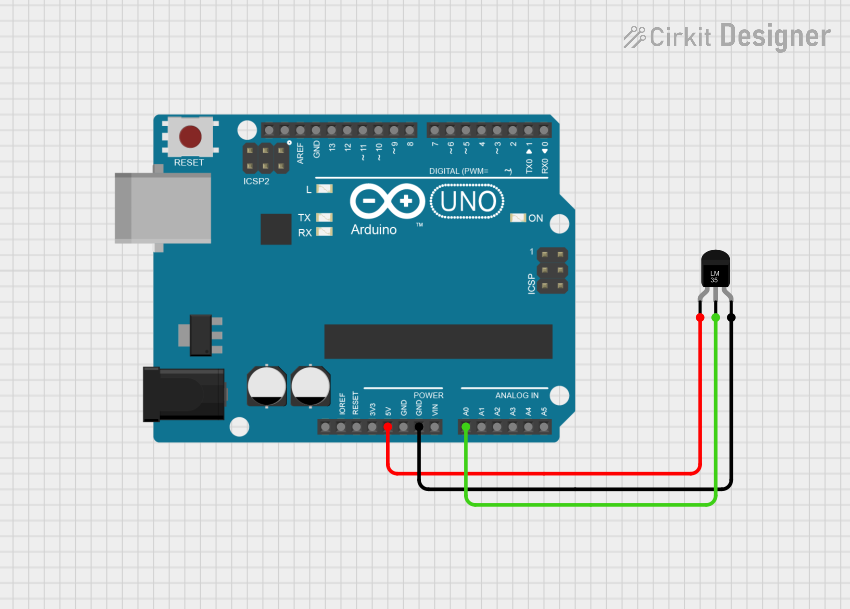
How to Use LM35 Temperature Sensor Module: Examples, Pinouts, and Specs

 Design with LM35 Temperature Sensor Module in Cirkit Designer
Design with LM35 Temperature Sensor Module in Cirkit DesignerIntroduction
The LM35 is a precision temperature sensor that provides an output voltage proportional to the temperature in Celsius. It is widely used in temperature measurement and control applications due to its linear output and ease of interfacing with microcontrollers. The LM35 does not require external calibration and offers a high level of accuracy, making it ideal for a variety of applications.
Explore Projects Built with LM35 Temperature Sensor Module

 Open Project in Cirkit Designer
Open Project in Cirkit Designer
 Open Project in Cirkit Designer
Open Project in Cirkit Designer
 Open Project in Cirkit Designer
Open Project in Cirkit Designer
 Open Project in Cirkit Designer
Open Project in Cirkit DesignerExplore Projects Built with LM35 Temperature Sensor Module

 Open Project in Cirkit Designer
Open Project in Cirkit Designer
 Open Project in Cirkit Designer
Open Project in Cirkit Designer
 Open Project in Cirkit Designer
Open Project in Cirkit Designer
 Open Project in Cirkit Designer
Open Project in Cirkit DesignerCommon Applications
- Environmental monitoring systems
- HVAC (Heating, Ventilation, and Air Conditioning) systems
- Industrial temperature control
- Home automation
- Weather stations
- Medical devices
Technical Specifications
The LM35 Temperature Sensor Module is designed for ease of use and reliable performance. Below are its key technical details:
Key Technical Details
- Operating Voltage: 4V to 30V DC
- Output Voltage: 10mV per °C
- Temperature Range: -55°C to +150°C
- Accuracy: ±0.5°C (at 25°C)
- Current Consumption: 60 µA (typical)
- Output Impedance: Low (less than 1Ω)
- Response Time: 1 second (typical)
- Package Type: TO-92 (commonly used)
Pin Configuration and Descriptions
The LM35 sensor typically comes in a 3-pin TO-92 package. Below is the pinout and description:
| Pin Number | Pin Name | Description |
|---|---|---|
| 1 | VCC | Power supply input (4V to 30V DC) |
| 2 | VOUT | Analog output voltage proportional to |
| temperature (10mV/°C) | ||
| 3 | GND | Ground (0V reference) |
Usage Instructions
The LM35 is straightforward to use in a circuit. Follow the steps below to integrate it into your project:
Connecting the LM35
- Power the Sensor: Connect the VCC pin to a 5V or 3.3V power supply (depending on your system).
- Ground Connection: Connect the GND pin to the ground of your circuit.
- Read the Output: Connect the VOUT pin to an analog input pin of your microcontroller or ADC (Analog-to-Digital Converter).
Important Considerations
- Bypass Capacitor: Place a 0.1 µF ceramic capacitor between VCC and GND to filter noise.
- Output Voltage: The output voltage is directly proportional to the temperature in Celsius. For example, at 25°C, the output voltage will be 250mV.
- Avoid Overheating: Ensure the sensor is not exposed to temperatures beyond its specified range (-55°C to +150°C).
- Wiring Length: Keep the wiring between the sensor and the microcontroller as short as possible to minimize noise.
Example: Interfacing LM35 with Arduino UNO
Below is an example of how to connect and read data from the LM35 using an Arduino UNO:
Circuit Diagram
- VCC: Connect to Arduino 5V pin.
- GND: Connect to Arduino GND pin.
- VOUT: Connect to Arduino analog pin A0.
Arduino Code
// LM35 Temperature Sensor Example with Arduino UNO
// Reads temperature in Celsius and prints it to the Serial Monitor
const int sensorPin = A0; // LM35 output connected to analog pin A0
float temperature; // Variable to store the temperature value
void setup() {
Serial.begin(9600); // Initialize serial communication at 9600 baud
}
void loop() {
int sensorValue = analogRead(sensorPin); // Read the analog value from LM35
float voltage = sensorValue * (5.0 / 1023.0); // Convert ADC value to voltage
temperature = voltage * 100.0; // Convert voltage to temperature (10mV/°C)
// Print the temperature to the Serial Monitor
Serial.print("Temperature: ");
Serial.print(temperature);
Serial.println(" °C");
delay(1000); // Wait for 1 second before the next reading
}
Best Practices
- Use a stable power supply to ensure accurate readings.
- Avoid placing the sensor near heat sources or in direct sunlight for precise measurements.
- If long wires are necessary, consider using shielded cables to reduce noise.
Troubleshooting and FAQs
Common Issues and Solutions
No Output or Incorrect Readings
- Cause: Incorrect wiring or loose connections.
- Solution: Double-check the connections and ensure the VCC, GND, and VOUT pins are correctly connected.
Fluctuating Temperature Readings
- Cause: Electrical noise or unstable power supply.
- Solution: Add a 0.1 µF capacitor between VCC and GND to filter noise.
Output Voltage Does Not Match Expected Temperature
- Cause: Incorrect ADC reference voltage or calculation error.
- Solution: Verify the ADC reference voltage in your microcontroller and ensure the formula for temperature conversion is correct.
Sensor Overheating
- Cause: Operating the sensor beyond its specified temperature range.
- Solution: Ensure the sensor is used within the -55°C to +150°C range.
FAQs
Q1: Can the LM35 measure negative temperatures?
Yes, the LM35 can measure temperatures below 0°C. However, the output voltage will be negative, so additional circuitry or software adjustments may be required to interpret the readings.
Q2: Can I use the LM35 with a 3.3V power supply?
Yes, the LM35 can operate with a supply voltage as low as 4V. However, for 3.3V systems, consider using a level shifter or ensure the microcontroller's ADC can handle the reduced output voltage range.
Q3: How do I improve the accuracy of the LM35?
To improve accuracy, ensure the sensor is properly calibrated, use a stable power supply, and minimize noise by adding a bypass capacitor.
Q4: Is the LM35 waterproof?
No, the LM35 is not waterproof. For outdoor or liquid temperature measurements, consider using a waterproof housing or a different sensor designed for such applications.
By following this documentation, you can effectively integrate the LM35 Temperature Sensor Module into your projects and achieve accurate temperature measurements.